Cultural Differences in Matrimonial Practices Around the World |Nest Matrimony
Posted on 8 November
1. India: Celebrating Marriage with Colorful Rituals
Traditional Ceremonies: Indian weddings are grand, multi-day celebrations that often include the Mehndi (henna) ceremony, Sangeet (musical evening), and the main wedding ceremony, which varies across regions and religions.
Arranged Marriages: Although love marriages are more common now, many Indian weddings are still arranged by families who place importance on cultural compatibility.
Diverse Rituals: From Hindu ‘Saat Phere’ (seven sacred rounds around a fire) to the Sikh ‘Anand Karaj’ ceremony, Indian weddings celebrate a rich blend of customs.
2. China: The Symbolism of Red and the Tea Ceremony
Color Symbolism: Red is the primary color in Chinese weddings, symbolizing prosperity, luck, and happiness.
Betrothal Gifts: Known as "bride price" or "pin jin," the groom's family often presents the bride’s family with gifts, symbolizing respect and good fortune.
Tea Ceremony: Newlyweds honor their elders by serving tea as a sign of respect, often receiving blessings and red envelopes with money.
3. Japan: Shinto Weddings and Traditional Kimonos
Shinto Shrine Ceremonies: Many Japanese couples marry at Shinto shrines, with rituals led by Shinto priests.
Traditional Attire: Brides often wear an all-white kimono called ‘shiro-muku’ for the purity and then change into a colorful one for the reception.
Sake-Sharing: The couple shares cups of sake (rice wine) in a ritual known as ‘San San Kudo,’ symbolizing unity and commitment.
4. Africa: Community-Centric and Symbolic Rites
Lobola and Dowries: In South Africa, the groom pays a "lobola" (bride price) as a gesture of gratitude toward the bride's family.
Dances and Drums: African weddings are often vibrant celebrations with singing, dancing, and drumming, involving both families and the community.
Kola Nuts Ceremony: In West African cultures like Nigeria, kola nuts are shared as symbols of respect, unity, and the couple’s readiness to start their new life together.
5. Middle East: Lavish Celebrations and Henna Nights
Henna Night: Similar to India, a henna ceremony is held where brides are decorated with intricate henna designs, symbolizing joy, beauty, and fertility.
Separate Celebrations: In many Middle Eastern cultures, it’s common for men and women to celebrate separately, especially in more conservative families.
Gold and Jewelry: The groom often gifts gold jewelry to the bride, symbolizing wealth, security, and love.
6. Jewish Weddings: Breaking the Glass and Chuppah
Under the Chuppah: Jewish weddings often take place under a canopy called the ‘chuppah,’ symbolizing the couple’s new home.
Breaking of the Glass: At the ceremony's end, the groom breaks a glass, a tradition that signifies the fragility of relationships and the importance of cherishing love.
Ketubah Signing: The marriage contract, or ‘ketubah,’ outlines the responsibilities and obligations of the groom toward the bride.
7. Europe: Diverse Traditions Across Countries
Norwegian Bridal Crowns: In Norway, brides traditionally wear silver or gold crowns adorned with small charms to ward off evil spirits.
German Log-Sawing Ceremony: In Germany, couples saw a log together, symbolizing their ability to overcome obstacles as a team.
Greek Money Dance: In Greek weddings, family and friends pin money to the bride and groom’s clothes as they dance, symbolizing prosperity.
8. United States: A Fusion of Cultural Influences
Something Old, New, Borrowed, Blue: Many American weddings follow this tradition for good luck and continuity.
Unity Candle Ceremony: Some couples light a candle together to symbolize the merging of two families.
Cultural Blending: American weddings often blend customs from multiple cultures, reflecting the country’s diversity.
9. South America: Coin Traditions and La Hora Loca
Coins and Lazo: In many Latin American cultures, the groom gives the bride 13 gold coins, symbolizing his commitment to support the family.
La Hora Loca: In countries like Peru and Venezuela, weddings feature ‘La Hora Loca’ (the crazy hour) with costumes, props, and lively dancing as a high-energy part of the celebration.
Catholic Influence: Many South American weddings follow Catholic traditions, with Mass often preceding the marriage vows.
Each of these practices showcases the rich diversity and cultural significance embedded in matrimonial ceremonies worldwide, with each culture emphasizing community, blessings, unity, and joy in distinct ways.
















